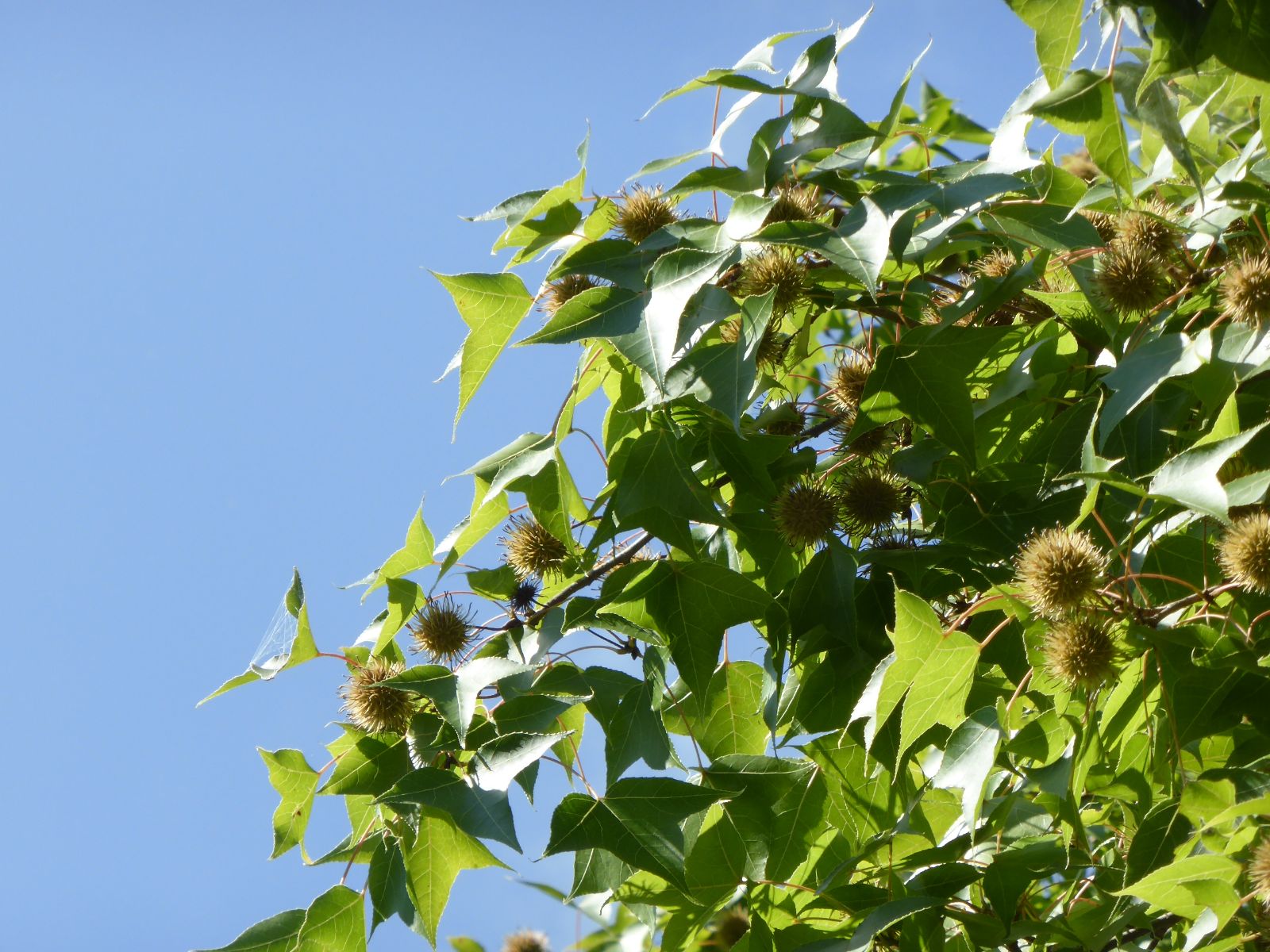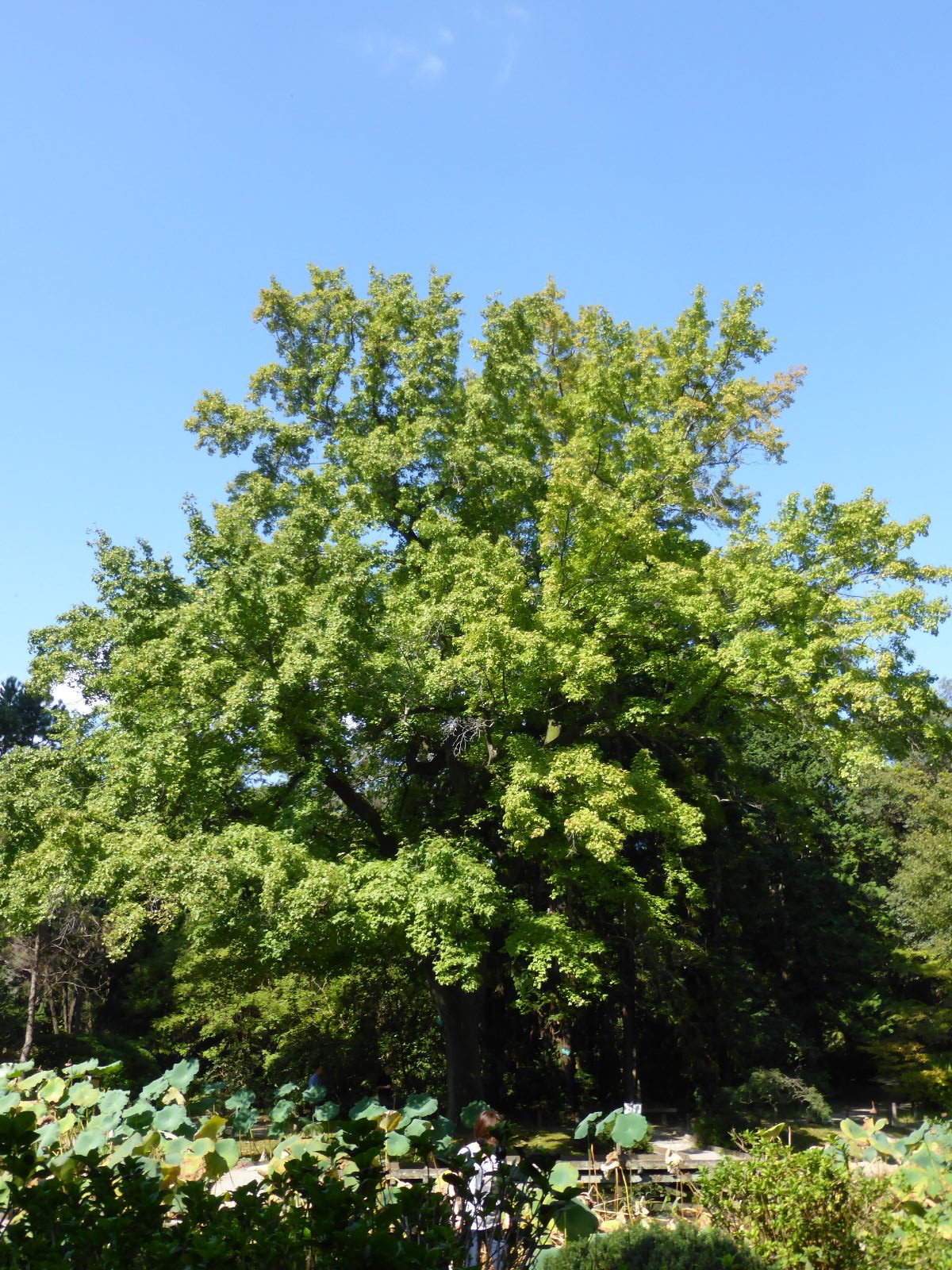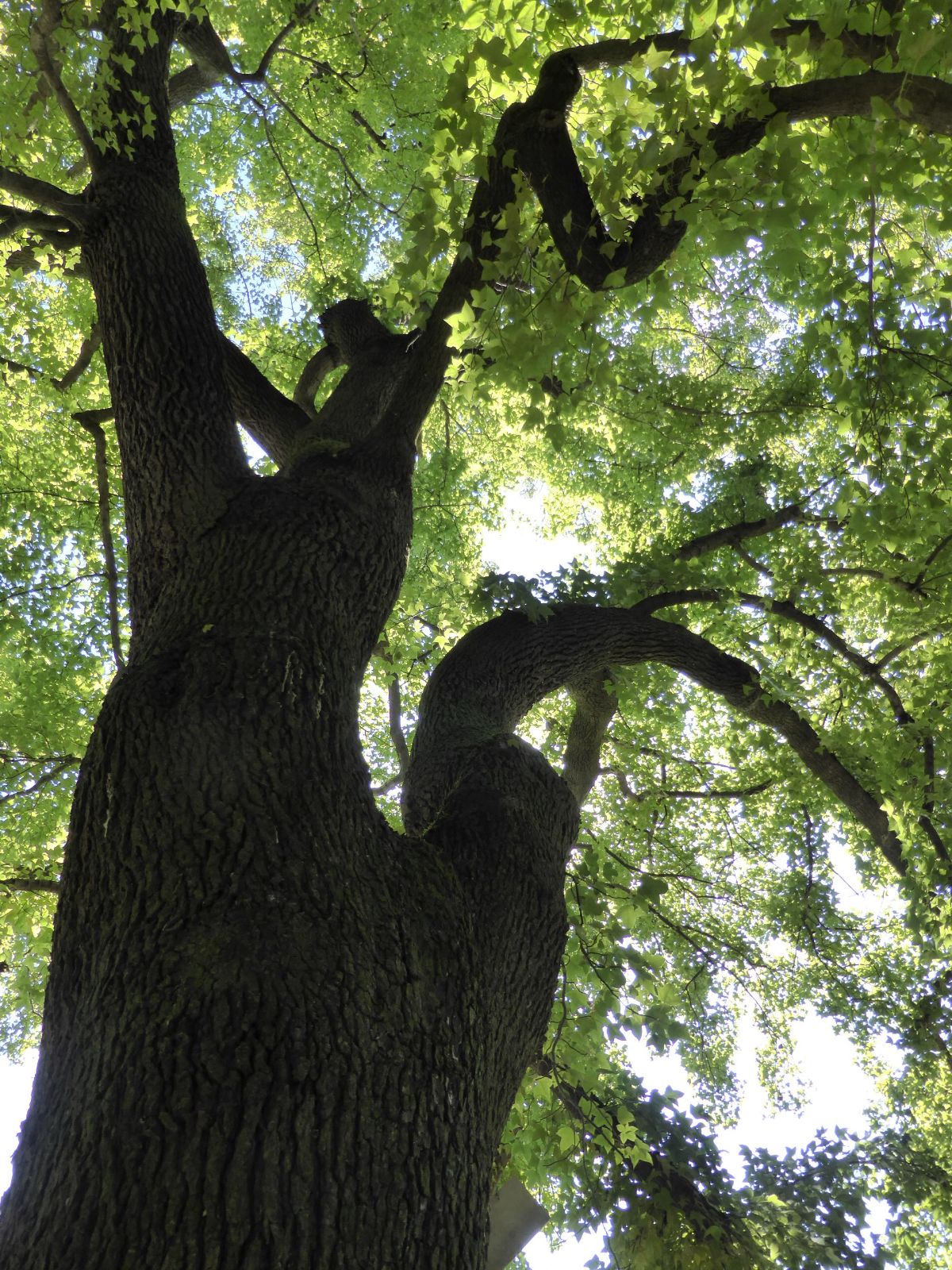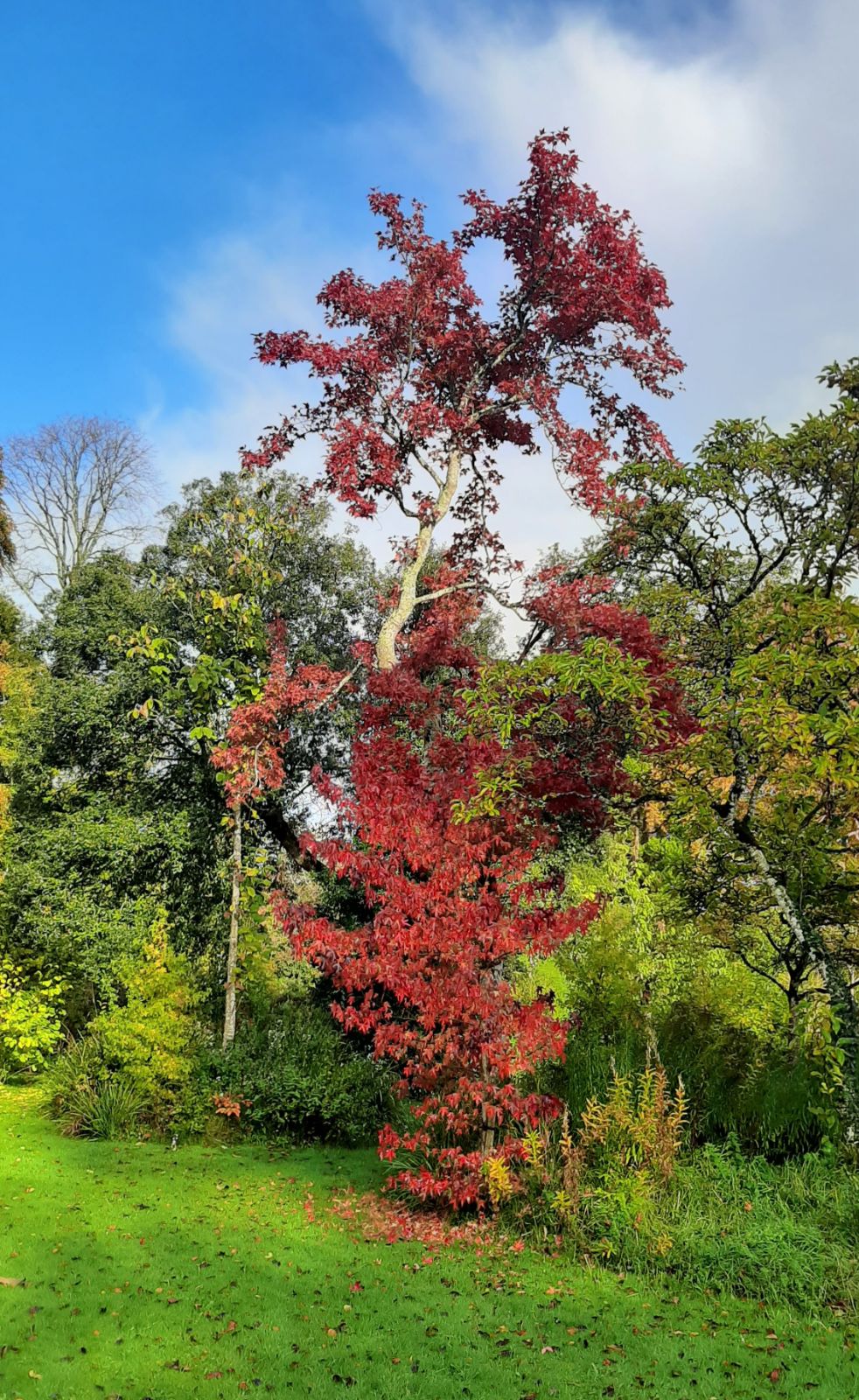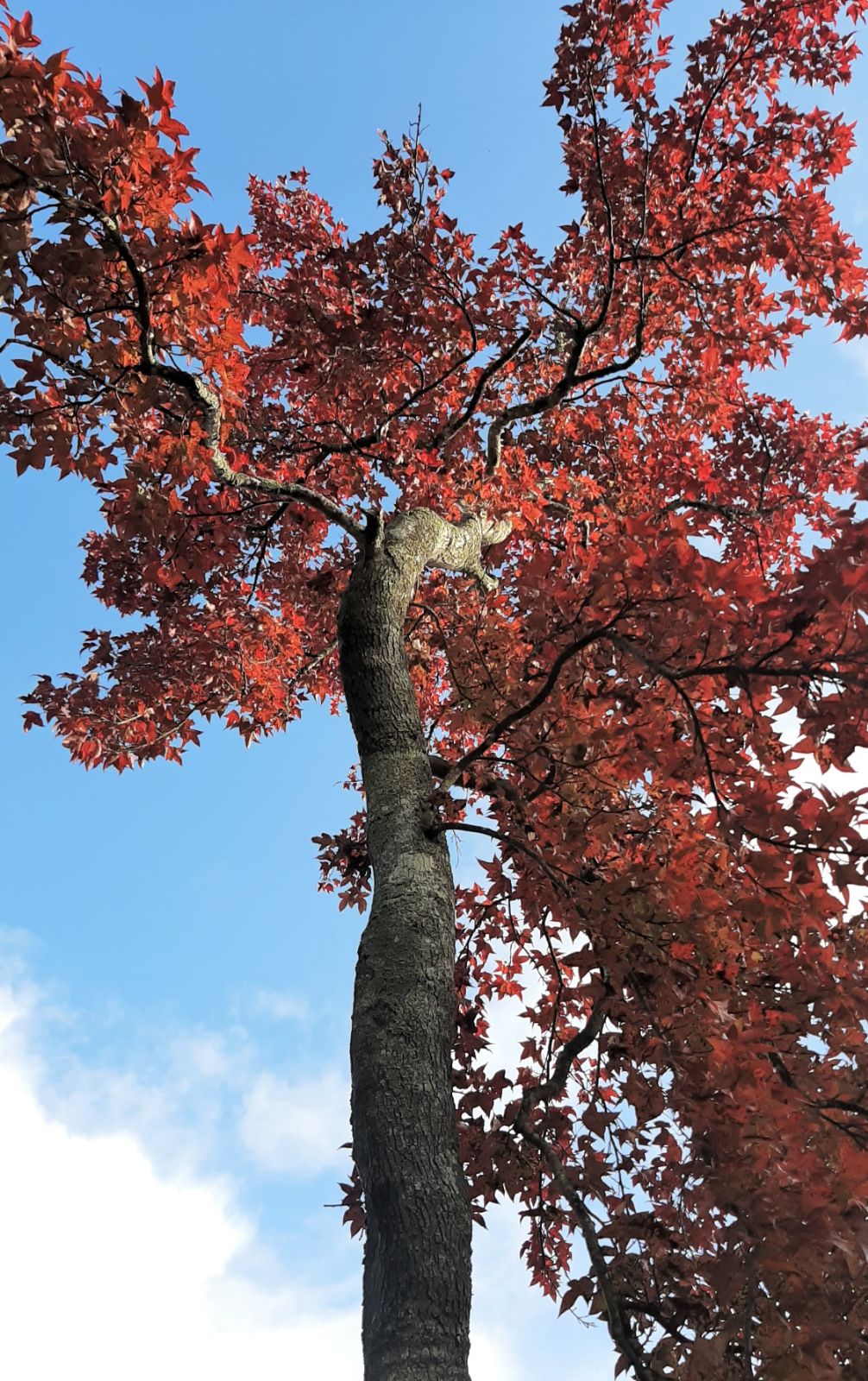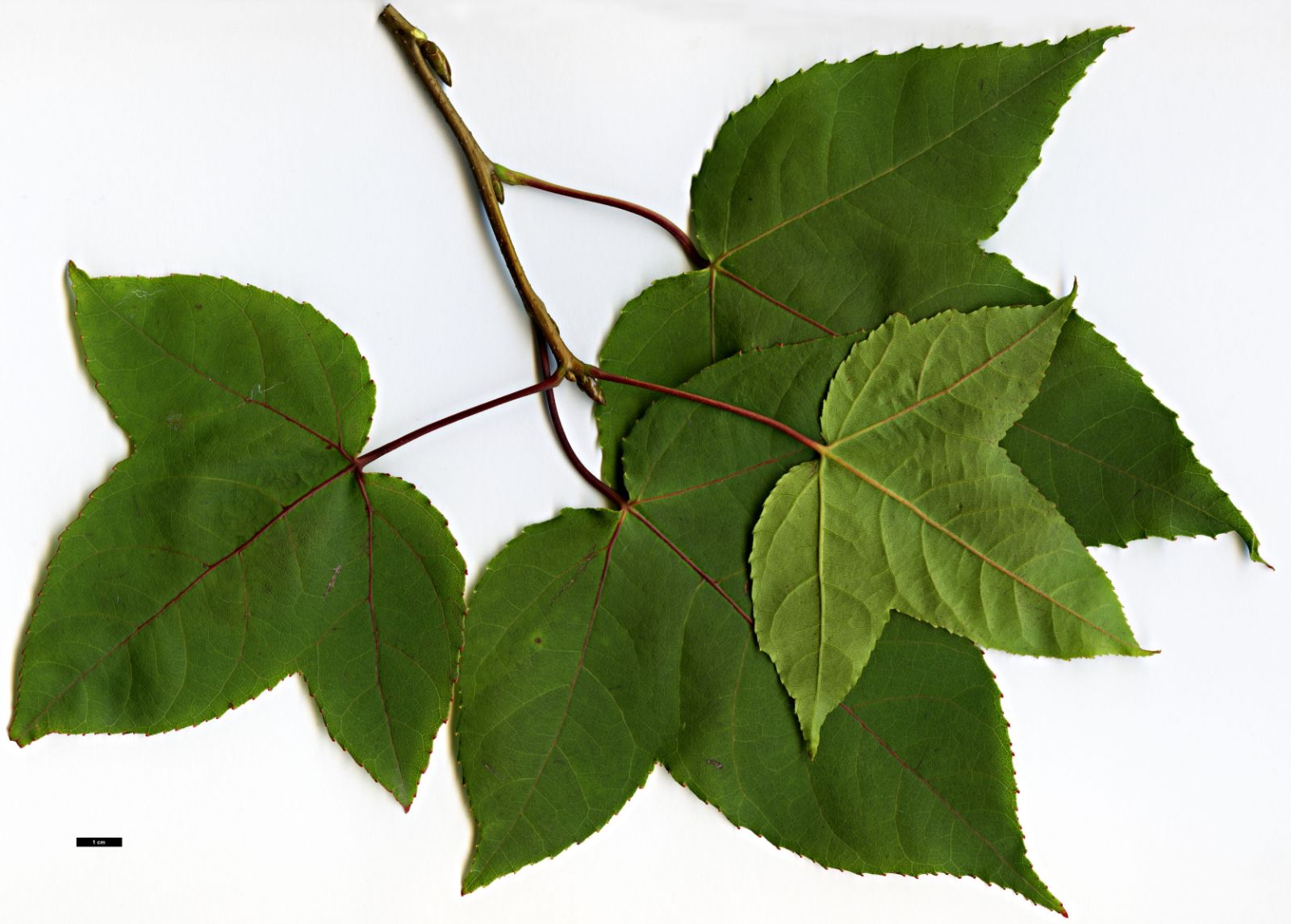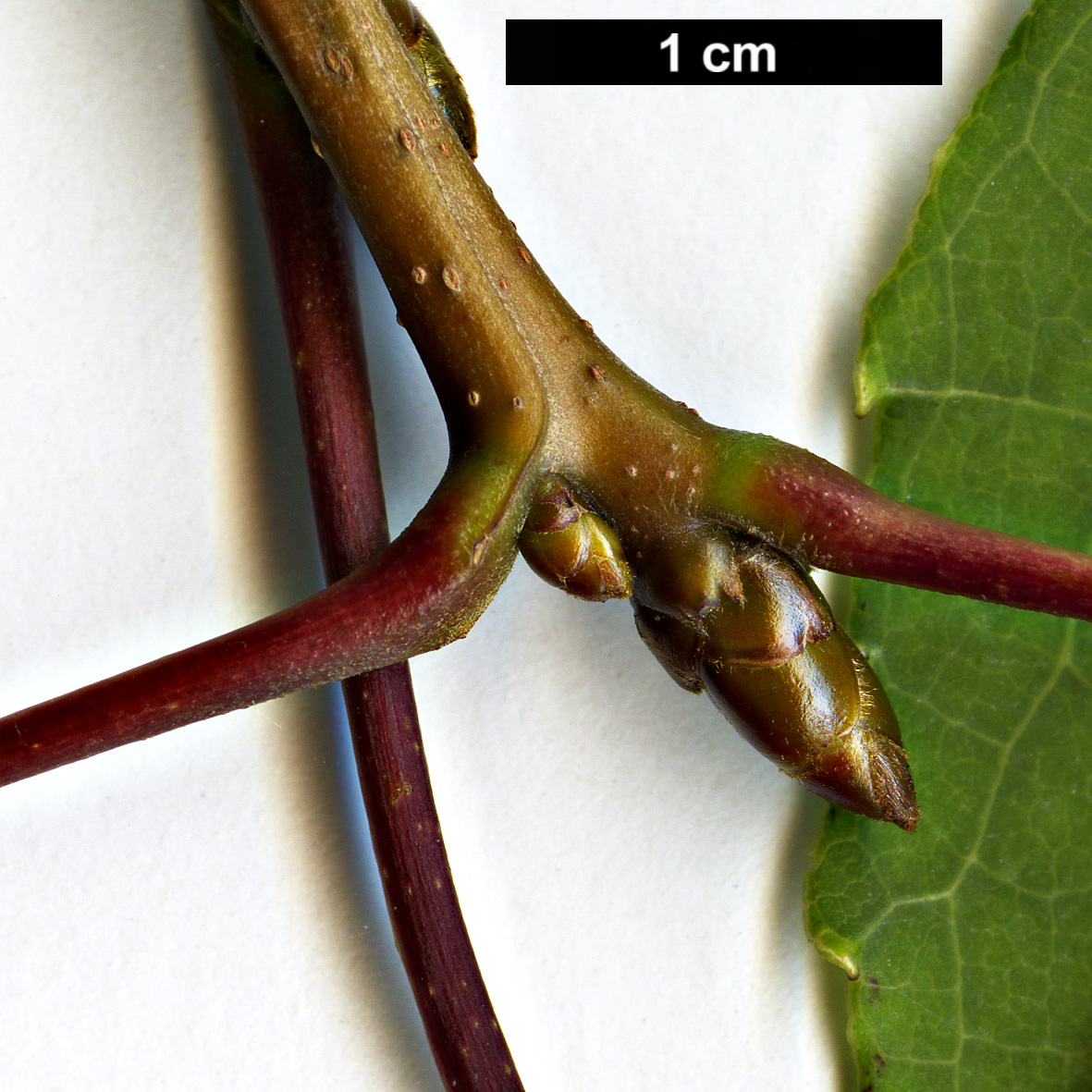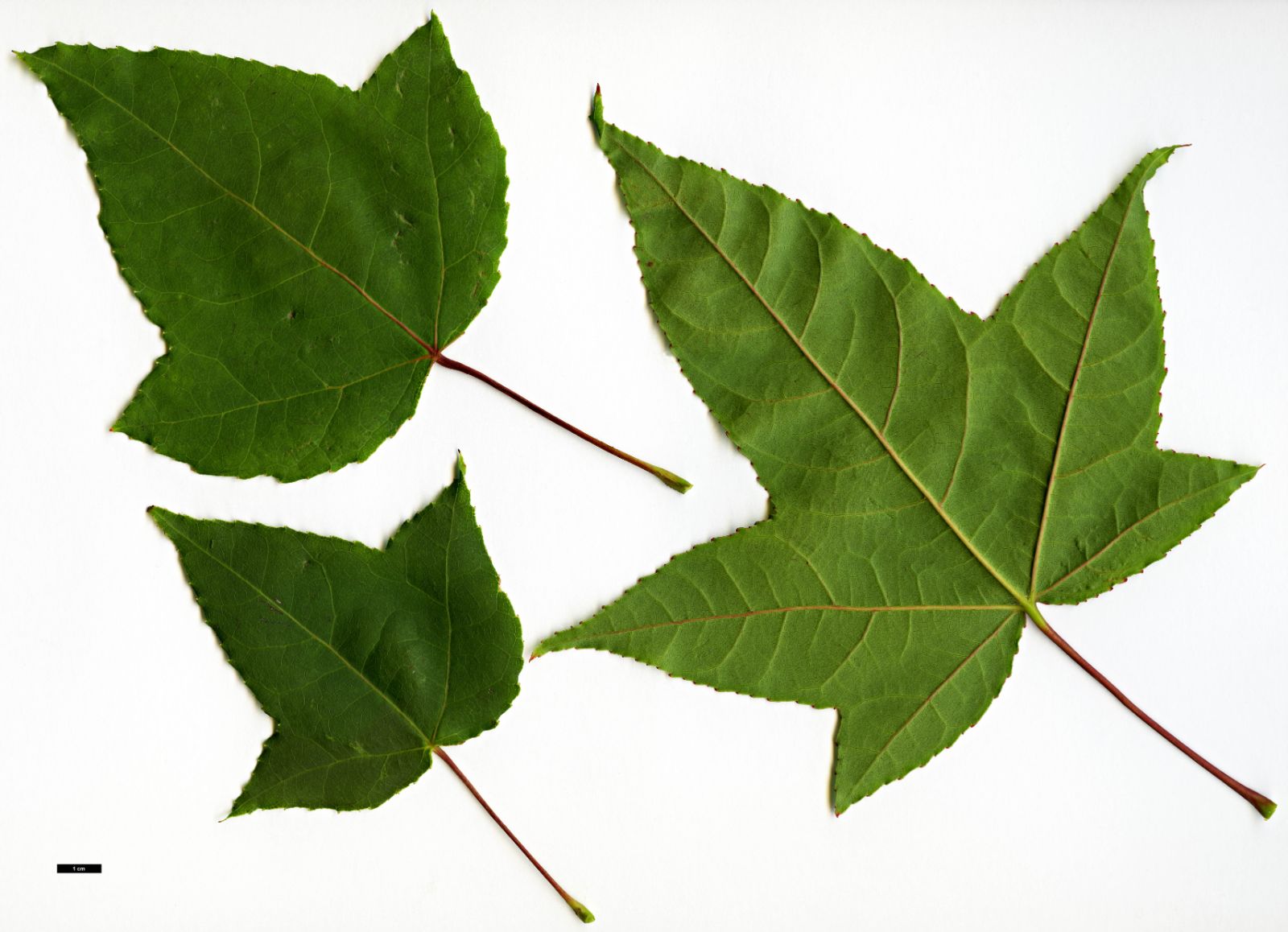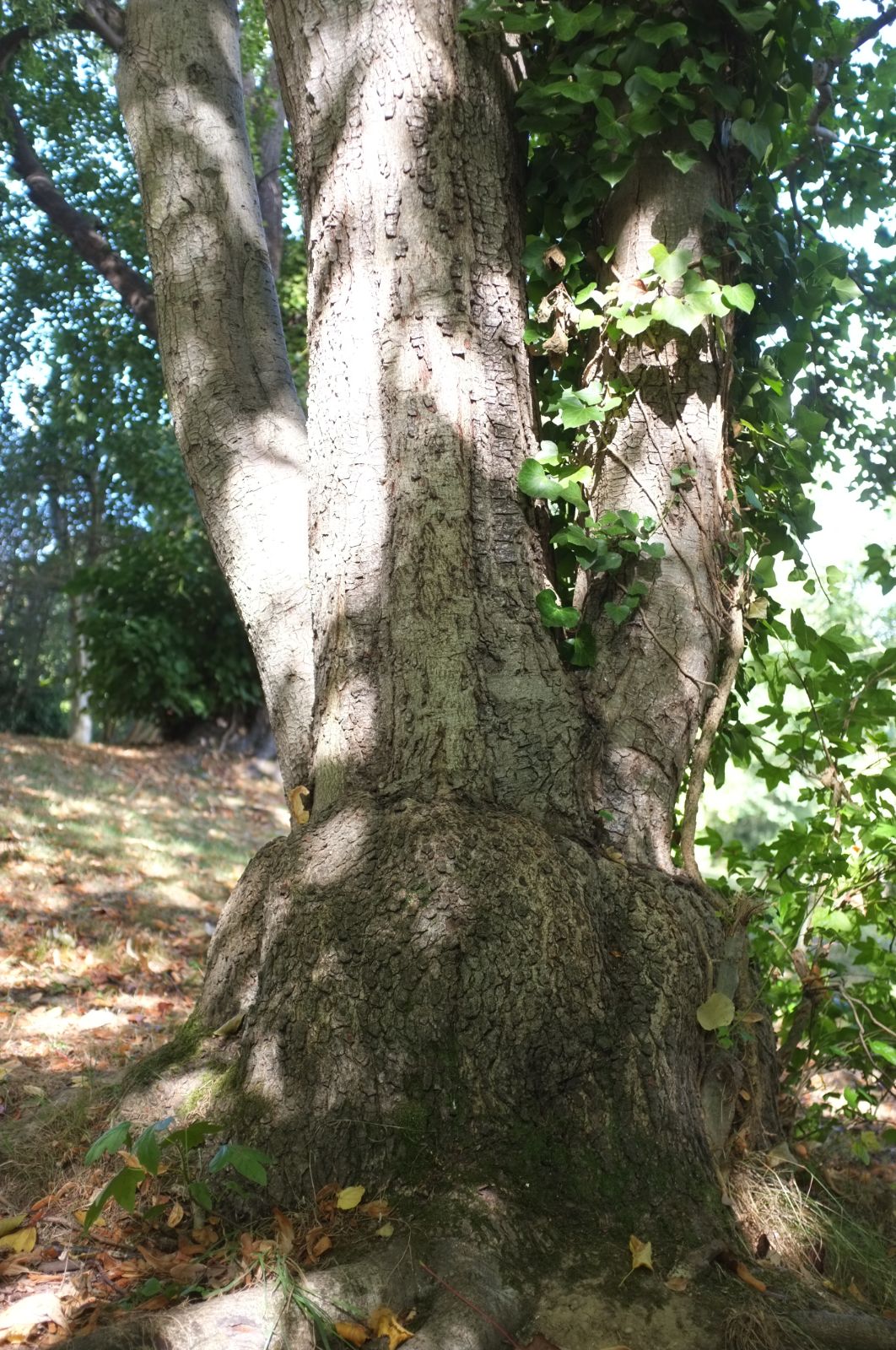Liquidambar formosana
Sponsor
Kindly sponsored by a member of the International Dendrology Society.
Credits
Owen Johnson (2021)
Recommended citation
Johnson, O. (2021), 'Liquidambar formosana' from the website Trees and Shrubs Online (treesandshrubsonline.
Genus
Common Names
- Chinese Sweet-gum
Synonyms
- Liquidambar acerifolia Maxim.
- Liquidambar formosana var. monticola Rehd. & Wils.
- Liquidambar maximowiczii Miquel
- Liquidambar tonkinensis A. Chevalier
Tree to 30 m; bark grey, smooth, developing shallow cracks after c. 30 years and ultimately more rugged and browner. Young branches sometimes with corky projections. Shoots sometimes pubescent; buds pointed, many-scaled, with a dense silky pubescence. Stipules red, 1–1.4 cm. Petiole 8–12 cm, pubescent. Leaf broadly ovate, 8–13 × 8–15 cm, 3-lobed (5-lobed on saplings), the central lobe longest and broadly triangular, rarely lobulate; margin with a glandular serration; matt dark green above, paler beneath and sometimes pubescent. Female inflorescence with 24–43 flowers; peduncle 3–6 cm. Fruit-ball 3–4 cm wide, each capsule beaked and also subtended by a bristle-like scale. Flowering March–June, fruiting July–September (China). (Zhang, Zhang & Endress 2003).
Distribution China Anhui, Fujian, Guangdong, Guizhou, Hainan, Hubei, Jiangsu, Jiangxi, Sichuan, Zhejiang South Korea Laos Mountains in the north of the country Vietnam Mountains in the north of the country Taiwan
Habitat Montane forests, 500–2500 m asl, and in open areas near villages.
USDA Hardiness Zone 7b
RHS Hardiness Rating H5
Conservation status Not evaluated (NE)
Liquidambar formosana is a tree with a vast natural distribution, extending from the temperate hill forests of central China and South Korea to subtropical mountain tops in South Asia. Seed was first sent to the United Kingdom by C.G. Alabaster, the British Consul in Wuhan in 1884, and a plant was grown against the wall of the Herbaceous Garden at Kew (Bean 1981). In 1907, Wilson sent seed collected at 600–1,200 m asl in western Hubei (W 218, W 513, W 795 (Global Biodiversity Information Facility 2021)); coming from the northern end of the tree’s range, these collections proved hardy in southern Britain, though plants sometimes failed to ripen their wood in the short summers of the early 20th century (Bean 1981). Seedlings were being sold by Veitch and Sons by 1911, when one was planted at Caerhays Castle in Cornwall (Tree Register 2021). At the Royal Botanic Garden Edinburgh, a repropagation from W 513 was planted in 2008 on the Pond Lawn (Royal Botanic Garden Edinburgh 2021). W 795 in particular was distinguished by Rehder and Wilson in 1913 as ‘var. monticola’ but has since been accepted as part of the species’s natural variety; the name Monticola Group is occasionally still used to indicate the extra hardiness of this stock. Leaves of these trees can flush a good purplish red, and Bean (Bean 1981) also describes crimson autumn colour – a feature that, as in all Liquidambar, will depend on how acid the soil is and how continental the microclimate. Subsequent introductions of L. formosana to Britain include one, represented at Borde Hill in West Sussex, with foliage of a fresher green and with some subsidiary lobules to its leaves, and one from Taiwan that proved more tender (Bean 1981). A more recent collection from China by Roy Lancaster (L/HC 22), grown at Nymans in West Sussex, was praised by David Masters at that garden for its superb red autumn colour, lasting from late October to mid-December (Hsu & Andrews 2005).
Over the last century L. formosana seems to have remained almost continually available in the United Kingdom. The stock tree at Keepers Hill Nursery in Dorset, grafted on L. styraciflua, survived in the car park of Marchants wholesale nursery in 2007, but has since been lost to redevelopment (Tree Register 2021). In general, however, this species has never rivalled its American cousin in popularity in the West and remains confined to bigger gardens in the United Kingdom. This said, one of the very largest grows in the author’s local public park, Alexandra Park in Hastings, East Sussex; it is 20 m tall and grafted at the base on L. styraciflua, above which are several sinuous stems to 41 cm dbh, presumably as a consequence of early cold damage. Planted on neutral clay in a maritime microclimate, this specimen stays stubbornly dark green through spring, summer and autumn and has probably coloured my appreciation for the species, though its foliage is undeniably elegant; in recent warm summers, it has started to fruit quite freely. A 13 m tree at Trent College in England’s north Midlands, planted by schoolmaster and dendrologist the Rev. G.J.S. Warner in the mid-20th century, is the northernmost good example on the Tree Register database (Tree Register 2021). In southwest Ireland, stunted trees survive at Fota and Parknasilla, while the older of two mature trees at Birr Castle in the Irish midlands, planted in 1934, has retrenched in recent years (Tree Register 2021); despite a marginally alkaline soil, the species can colour very well here. The need for some summer warmth seems a more significant issue here than the species’s ultimate hardiness.
On the near continent, one at the Arboretum Trompenburg in the Netherlands was purchased from Hilliers in 1965 and had reached 10 m by 2005, showing outstanding autumn colour (Hsu & Andrews 2005). In the eastern United States, fruit production can be profuse; there are specimens at the University of Georgia at Athens and at Scott Arboretum in Pennsylvania (Hsu & Andrews 2005), but this tree has failed to survive hard winters further north at the Arnold Arboretum in coastal Massachusetts.
The species’s wide range extends towards the tropics, and it succeeds as an urban tree in Bangkok (Wikipedia 2021) and on the Townsville Campus of James Cook University in northeast Queensland, Australia (James Cook University). Roy Lancaster has also observed it as a street tree in Guangzhou in the south of China, where it tolerates extreme air pollution and soil compaction (Hsu & Andrews 2005), and Tom Christian has seen it in Kyoto, with equally hot, sticky, humid summers, but somewhat cooler winters (T. Christian pers. comm. 2021).
At Osborne House on the Isle of Wight, one of two mature specimens flanking the Swiss Cottage is typical, while the other has three-lobed leaves but shows the rugged brown bark and stiffer habit characteristic of L. styraciflua (Tree Register 2021), suggesting the possibility of hybrids arising in cultivation between these two species. The apparently lost clone ‘Fremont’, attributed to L. styraciflua, was described as evergreen in California, and Michael Dirr (Dirr 2009) suggested that this may have been a hybrid with L. formosana (or with L. orientalis, which should have resulted in an obviously different leaf shape). An ‘evergreen’ (or ‘semi-evergreen’) clone of L. formosana is also sold by Yamina Rare Plants in Australia, but, as Liquidambar is grown largely for its autumn colour, the advantages of such a variant seem moot. Among other named selections of L. formosana, ‘Burgundy Flash’ (Hatch 2018–2020) seems likely to be a sales error for L. acalycina ‘Burgundy Flush’ (q.v.).
'Afterglow'
A clone selected for the rich purple of its young growth at the Saratoga Horticultural Foundation in California and distributed from 1961 (Santamour & McArdle 1984). It is now sold in the United Kingdom by Bluebell Nursery, where it is recommended for its rose red and orange autumn colours (Bluebell Arboretum and Nursery 2020).
'Ellen'
A selection with deep red new growths, sold by Plantentuin Esveld in the Netherlands from around 2009 (Hatch 2018–2020). Esveld’s (2021 catalogue) lists this clone under L. styraciflua, but the accompanying photo clearly identifies it as L. formosanum.
'Jinjue'
A recent selection by the Ningbo Forestry Bureau in China, with gold twigs and leaves that flush yellow (Hatch 2018–2020); if it is as good as the equivalent mutation in L. styraciflua, ‘Golden Sun’ (q.v), it may become a valued garden plant. An unnamed ‘yellow-leaved selection’ observed some years ago in America by Michael Dirr (Dirr 2009) may perhaps have represented the same sport.
Monticola Group
Hardy, glabrescent plants from western Hubei (W 795) and from eastern Sichuan were originally distinguished as var. monticola by Alfred Rehder and Ernest Wilson (Bean 1981), and the name is sometimes used to indicate scions from collections from this area.


